On Sunday, July 31, we leave Katima Mulilo and Namibia.
The Wenela Border Crossing is efficient and it does not take long until the Namibian Cross Border Permit is cancelled and the passport stamped.
Then we reach the exit gate where the vehicle details have to be entered in a book.
Funny enough even though they want the engine number they don't ask for the engine brand........
Logical!
A Toyota has a Toyota engine so an OKA must have an OKA engine .... or not .....?
As in Mata-Mata where we entered Namibia here too nobody asks for the Carnet de Passage.
That is ok for us as we don't have an entry stamp anyway .....
Then we cross the no-mans-land and are pointed to a parking area.
If nobody had pointed us to the parking area we would have driven past the Shesheke Border Crossing without even noticing it.
Helpful money changer want to sell us their local currency Kwachas but we are not really interested.
We intend to pay the cross border costs and insurance with the remaining Namibian $, South African Rand and where required use US$ and then use an ATM in Livingstone to draw Kwachas.
We have tried to figure out how much the exchange rate is but have not really been successful .....
The bank statement will give us a more accurate information on it.
The Zambian process of immigration is a bit more complicated ........
First we have to get a visa - 50 US$ per person.
The longest visa they can give is for 30 days but one has the option to extend it for up to 90 days if required ..... but they cannot issue it for 90 days from the beginning .....
Well, so be it.
While Ruedi has to enter the vehicle details in a large book Susi chats with the officials about what local music they can recommend.
Both of them immediately say Angela Nyirenda.
They also recommend Sakala Brothers, Ameyenge Band and P.K. Chishala.
Ok we will try to listen to some of it.
Then a lady comes into the room and picks us up for the next few forms and payments: Insurance and Carnet de Passage.
The insurance is for 3 months and costs 75 US$.
In Livingstone we will be able to get the COMSEA Yellow Card insurance which will be valid up to Kenya.
Then the lady explains that we have to get 3 more receipts and then come back to her.
The office next door is responsible for carbon tax (yes, you read right!).
The office is a bit special with respect to that in front of one whole wall used receipt books are piled up ...... probably the archive ......
Mind you, the data is entered in a computer and the receipt is a nice printed form.
We have to pay 200'000 Kwacha or 337 N$ / Rand for the 4 lt engine of the OKA for 3 months.
We only have 340 N$/Rand and she has no coins for change.
Ruedi says that Kwachas would be fine as change too so we get 6'000 Kwachas as change.
We try to figure out the exchange rate ........ but have to give up.
Next we have to leave the building and head over to a container, were the department of transport is represented.
Quickly we are issued with a receipt over 20 US$ and can proceed for the payment of the council fees.
The official points us to a caravan besides another container.
The caravan is a complete wreck without any windows .... totally cannibalized.
We assume that the office is in the container where some people are sitting in front of but a man jumps up and points us to the caravan.
There is no floor left at the entry and the table is dangerously tilting to one side.
But there is a book with receipts, an ink-pad and stamp there.
We are invited to come into the "office" and are offered to sit on the "sofa" but decide to remain standing ......
The man bangs his stamp
so strongly into the ink-pad and then onto the receipt that we now know why the table is tilting that much to one side .....
With the last receipt for 100 N$ for council fees in our hands we make it back to the lady in the first office.
All receipts are neatly stapled together and with the instructions to keep them handy as this is what we will have to show at every police checkpoint we are sent on our way.
Even though it was a complicated procedure we are pleasantly surprised about the efficiency and friendliness on how all was handled.
We would have loved to take pictures of the "offices" and the equipment but that would most probably not have been welcomed .....
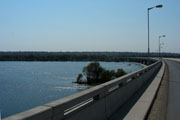
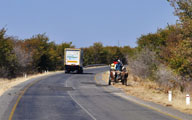
We cross the wide bridge that spans the Zambezi River and enter Zambia.
It does not take long and the bitumen road starts having potholes.
Later on the potholes have been prepared for repairs ..... but the repairs have not yet been done ........ resulting in the potholes now being rectangular with very sharp edges and one has to be very careful when driving through them to avoid tyre damage.
As there is very little traffic on the road slowing down for the holes is not a problem.
The bicycle seems to be a major form of transport.
We see many men dressed in suits on bicycle and guess that they are on the way back from Sunday mess.
We reach Livingstone and book in at the Maramba River Lodge.
It is set up very prettily in the Mosi-oa-Tunya National Park.
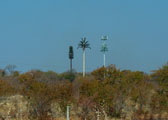
Then we head towards the Victoria Falls.
On the way we pass group of
mobile telephone towers.
Looks like we will have no problem organising our internet connection via Ruedi's old Nokia.
We should be on the bridge that crosses from Zambia over to Zimbabwe by 4 PM to meet Thomas and Lilli Concierges who will be coming from the Zimbabwe side.
But as we have not yet read the guide books we are not familiar with the organisation here and decide to visit the Victoria Falls World Heritage area first.
This later on backfires as we cannot reach the bridge from within the falls area.
We have to get out of the park and go around be able to reach the bridge.
But that story a bit later ......
We have definitively reached a touristic Mecca:
5 US$ for parking and 20 US$ per person entry fee to see the falls from the Namibian side.
We head down to the falls and are impressed about the many Africans that are here as tourists too.
Ok, they pay heaps less but still, they are here in large groups, school classes, youngsters, etc.
We even see a bride and groom ..... the white dress will most probably suffer a bit with all the spay water and dirty grounds .....
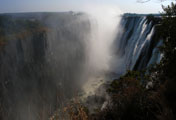
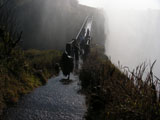
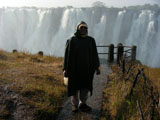
The falls are very active and lots of spray is in the air.
As we did not bring our rain gear we hire coats (1 US$ p. P.) and head onto the foot bridge.
It feels like walking in the rain with the exception that the sun is shining and the water comes from all directions.
It makes taking pictures quite difficult .... an underwater-camera would probably be more appropriate ......

But the rainbows are best when lots of spray come up from the falls.
Soon we are completely soaked but it is great fun.
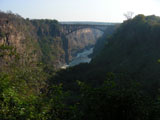
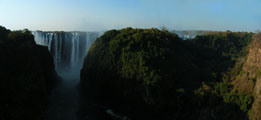
At 4 PM we get to the point closest to the bridge and check if Thomas and Lilli are on it but we did forget the binoculars and only have the small camera without telephoto-lens so it is guessing.
We hope that Thomas and Lilli will read our email we had sent them earlier where we proposed that we will be on the bridge tomorrow on our way back from the Zimbabwe side of the falls.
So after leaving the falls we decide to head down to border control to find out how we must do it tomorrow.
There we find out that it is possible to get onto the bridge without really exiting Zambia.
So we quickly decide to do that.
The process is very easy:
We are handed a small piece of paper with a stamp on it where the amount of people "covered" by this paper is written on.
With this paper we go to the officer at the gate and hand the paper in.
Now we are free walk around in the no-mans-area which includes the bridge, the bungee jump, a bar, the cable slide etc.
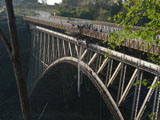
We reach the middle of the bridge at 4:30 PM but cannot spot Thomas or Lilli.
Let's hope we will see them tomorrow.
To re-enter into Zambia it is a similar process:
Report at immigration.
Get a piece of paper with a stamp on it and a "2" for two people, walk to the gate and hand it to the officer there ..... and you are in.
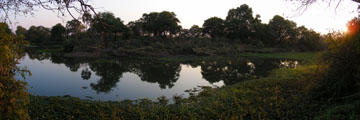
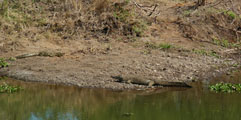
We head back to the camp and go for a walk to the restaurant and bar area where there is a water hole.
Two crocodiles sun themselves on the bank ..... one of them is quite large ......
Ok, looks like this water hole is really visited by animals!
And it has spotlights too so we will be back after dark.
When we come back after dinner it does not take long and we find a hippo happily munching away the greens ..... and that just about 5 – 10 m away from us!
Wow!
The hippo does not like us shining onto it with the torch at all, stops eating, disappears into the water and vanishes.
We try to find the spot where it resurfaces again but are not able to.
Amazing!
That is one of the reasons why hippos are considered so dangerous when one is on the water in a small boat; the hippos appear beside the boats (or even under the boats so that the boat tips over!) out of the blue and without any warning!
And do they have tusks!!!!!!
Apparently in Africa more people are killed by hippos than by any other wild animal.
On Monday morning we get on our bikes and pedal down to the border control.
We seem to be some kind of special thing ...... we are greeted by all the local on their bikes, the cars toot and gives us a "thumbs up" sign ........ lots of smiles everywhere .....
When we ask for a day-pass to visit the Zimbabwean side of the falls the officer informs us that we have a single entry visa which means that on re-entry we would have to pay the 50 US$ per person again.
Hmmmmmm ......
After yesterday's easy handling of the visit of the bridge we had expected something similar.
A bit disappointed we decide to skip this and first have a look at our further travel plans if we might have to get a multiple-entry visa which would cost heaps more but would enable us visit Zimbabwe and later possibly also Malawi and then re-enter Zambia.
So for the moment this plan is dead ......

We pedal back toward the camp and stop at the Royal Livingstone Hotel to have a look at their setting.
It is supposed to be the best place for a sun-downer ...... and we agree ....
Back on the main road and just a few hundred meters before our camp a car stands on one side and a bicycle on the other side and all people look in the same direction.
And what do we see?
Elephants!
Ruedi's adrenaline level climbs fast while Susi is busily chatting to the other bicycle driver to find out if he will stay here and watch too.
Yes, yes, no problem.
Ok.
So we stand here as well and watch the elephants nibble on the trees and then wonder off.
As they are heading in direction of our camp we drive over there.
On the dirt road toward the camp we don't know how far away the elephants are so Ruedi keeps ringing his bicycle bell so the animals can hear us .....
The man at the gate opens the gate for us and great us with a broad smile and a "welcome home".
We tell him about the elephants and he replies that they were at the water hole just a few minutes ago.
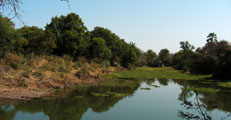
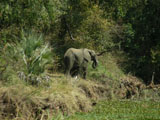
Quickly we head down and see one last one down there.
The crocodiles are also out again.
Back in camp we get organised and check the sat mail.
Tom and Dagmar, the German couple that we have met in South Africa and again in Namibia, are here too and will join us later on.
This is good as we need to plan our joint trip to Tanzania now.
In the afternoon we pedal back to the bridge.
This time we get two pieces of paper with a stamp and a "2" on it:
Two people and two bicycles!
We wonder how they can check that we don't sell the bicycles on the bridge and come back just as "two people" ........

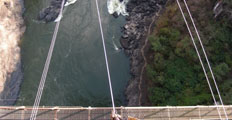
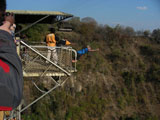
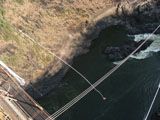

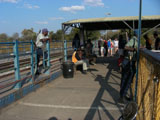
We watch the bungee jumpers and wait but Thomas and Lilli don't make it to the bridge.
Well, it wasn't meant to be ...... so be it!
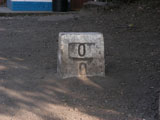
Right at the end of the bridge we find a stone with "0" on it.
Looks like the beginning of the main road .....
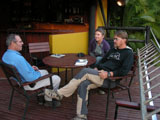
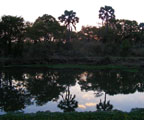
When we get back to the camp Tom and Dagmar have already arrived.
We chat and exchange the latest news and agree to have a sun-downer at the bar and discuss the routes and where we will meet.
A Defender with German plates arrives.
It is from the same town as Tom and Dagmar are.
How small is the world!
Then we go for dinner in the restaurant and celebrate the 1. August, the Swiss National Day.
On Tuesday morning we visit Livingstone and organise some things including the COMESA Card Jaune / Yellow Card.
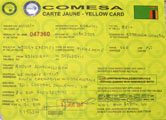
The COMESA Yellow Card is a motor vehicle insurance scheme which is valid in all the participating countries.
It covers third-party liabilities and medical expenses for the driver of the vehicle and his passengers should they suffer any bodily injury as a result of an accident to an insured vehicle.
It also facilitates cross border movement of vehicles between COMESA member countries as this card is valid in many parts of East Africa and motorists do not have to buy insurance cover at each border post they cross.
The insurance can be bought for one country only or for many countries which have to be listed on the receipt.
When we are asked which countries we do not want the insurance for we
decide that we will definitively not travel to Libya and Zimbabwe ....
When in Africa one should never assume that one will not travel through a country ...... we should have told them to make it valid for all available countries ..... the costs are the same anyway.
Anyway, happy with the insurance we leave the office and on the way out learn how to properly shake hands in Zambia:
One does not only shake hands, one also makes some kind of a "give-e-five" procedure, very amusing!
We will use it many more times and always receive a good laugh because we know about it.
We also go shopping in the nice shopping mall in town and are surprised about the good selection of food.
As we don't know how the rest of the country will be with regards to availability of cheese and meet we stock up once again.
We also get a local SIM card, some airtime and have it converted to Internet time.
The lady tells us, that the server is down and we will have to wait until tomorrow until it works.
So we go home and have an Internet-free and quiet evening.
On Wednesday we check the Internet access but it does not yet work.
Frustrated, because we had planned to leave towards Lusaka, we head into town again to complain.
The lady fiddles around with the phone and the card but somehow it does not work.
She will try later on and send us an SMS once it works .... ok, let's see .....
We leave Livingstone on the T1 which is in really good condition, fresh bitumen covers the road, no potholes.
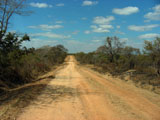
As we don't feel like driving on bitumen we pick a track shortly after Zimba that leads to the Lake Kariba.
At the beginning the track is in reasonably good but the further we get off the bitumen the more the track deteriorates .....
We drive past Luesi and cross a few dry river beds.
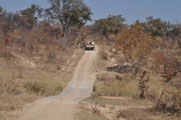

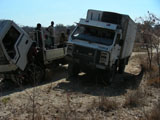
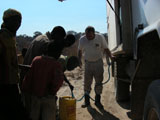
On the way uphill towards Kabanga we see a stranded truck.
We drive closer and see that they are pumping the tyres with a hand pump.
We offer them to pump the tyres with our air and they happily accept.
Then they ask us if we can spare some fuel so they can make it to their village.
Well, why not ..... a bit development-aid - helps improve the image of Australia ....
Close to Ruyota we reach a gravel road again and continue on towards Kabanga.
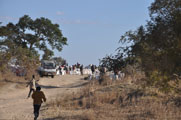
Kabanga seems to be the last "large" village.
Up to here the local farmers have to bring their corn so the trucks can pick it up and bring it to the larger towns.
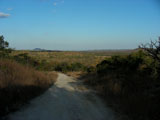

After Kabanga the road reverts back to a small track.
The villages we drive through don't have names and are not listed on the maps anymore.
After a village the track gets really narrow and starts tilting sideways.
In addition it starts heading down hill.
We have reached the Chijalile Ranges escarpment that heads down to Lake Kariba.
Our moving speed drops to 4 - 8 km per hour .....
As it is already late in the afternoon we stop at a telecommunication tower with a guard.
As we are a bit worried about the correctness of our maps
we ask him if the track leads down to Lake Kariba.
He speaks a bit of English and confirms that this is the correct track down to the lake and
he is sure that we can make it.
We ask, if we can stay at the tower for the night but the guard is not happy about it and wants us to return to the little town we had passed a few km back.
We are not interested in this and decide to continue on.
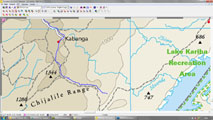
The track just does not get flat anymore.
In addition it does not match the track on the map anymore!
It goes down and down and down ..... past a few houses .... down again ..... in just 4 km we descend from 1010 m above sea level to 827 m.
It would be very difficult to turn the OKA around here and be able to head back uphill again ......
We are seriously worried
if the information that we had been given is correct.
Eventually it gets dark and there is no light to be seen anywhere.
We drive past a few houses and all is dark.
Only then we realise that people out here don't have electricity ..... and when it gets dark ..... they go to bed .....
So we decide to stop at the next possible area and stay there for the night.
As expected nobody bothers us during the night.
On Thursday morning as soon as dawn breaks we hear animal bells around the OKA and children walking past, probably on their way to school.
But nobody bothers us in any way, no knocking on the cabin, nothing.
What a nice surprise.
After breakfast we continue on ... downhill ..... but not much longer.
We had almost reached the end of the steep part when we stopped for the night .....
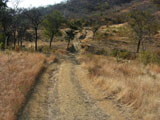
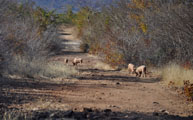
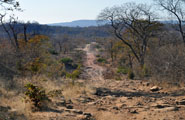
The track gets flatter and a bit better.
Then we reach
track that is on the map again.
We feel a lot better now and are almost sure that we will make it to Lake Kariba.
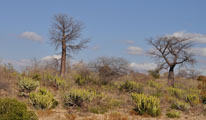
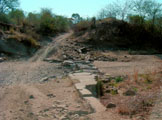
We come past Boabs and Cacti.
The rivers beds we have to pass are dry but it is obvious that they must have had some heavy rainfalls here recently.
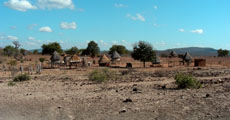
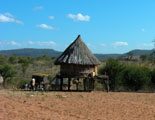
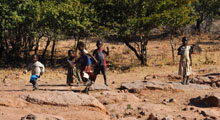
The villages are small and the track sometimes leads straight through them.
Adults watch us and the kids come running and wave.
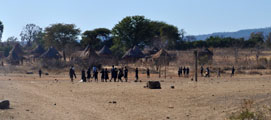
There are schools and the kids wear uniforms; each school has a different uniform.
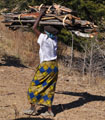
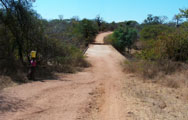
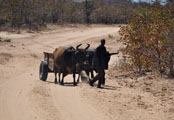
Daily business is developing and we get a bit of an idea how things out done here .... no frills and whistles, just basic survival .....
Then we reach Kanchindu and drive down to the lake.
The closer we come to
Siatwinda the more the road has suffered in the recent rains.
Lake Kariba still seems to be flooded and some areas and parts of the road are still under water.
Along the lake agriculture is very dominant.
Green fields and fruit orchards prosper.
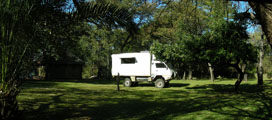
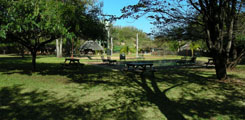
We reach the Kariba Bush Camp and stay for the night.
The pool and the bar are empty, we seem to be the only guests.
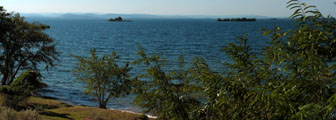
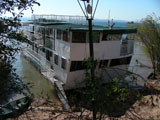
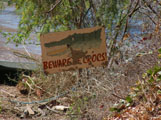
But it seems that there are other times ....... where the party boat is busy .....
Juts be aware of the crocodiles! .... no swimming in the lake!
On Friday morning, May 8, we head over to the office and enquire about the state of the road from Mwera to Sinazeze and further on to Chaboboma.
We are told that the company that runs the large mine in Maamba maintains the road from the mine to the T1 and the stretch Mwera - Sinazeze is all covered with bitumen.
The stretch
Sinazeze - Chaboboma had suffered a lot with the large rains they had had recently and the bridges had been washed away ..... but the government was busy building new bridges .....
As this information is a bit difficult to judge we ask if the road is better or worse than what we had come on ....
The answer is that if we were able to the track downhill we would have no problems with the track we want to drive.
With these good news we leave.
Soon we drive on beautiful flat bitumen and enjoy the country side.
The fields are green and well maintained, every so often we can get a glimpse of Lake Kariba.
Then we reach Sinazeze and leave the bitumen.
The road is not much more than a dirt track.
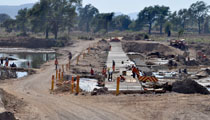

The first few bridges have been rebuilt but then we reach the last construction site .....
Where bridges had been we find deviations through the dry river beds.

Some of the "bridges" had been washed away partially and the part left was just wide enough to fit the OKA on it ... both wheels at the outer end of the track .....
Hmmmmm .....
Then
we reach a village and there seems to be no road further on.
We drive each sandy track .... only to come to a dead end in a field or whatever ....
We feel like in Greece where the tracks that seemed to be used the most where the wrong ones ... because everybody drove them twice: on the way in and on the way out!!!
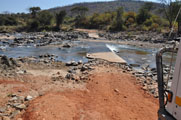
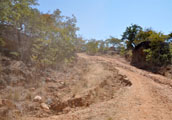
Finally we ask in the village and they point us towards the river where find a washed away crossing.
On the other side the track has not been driven for a while, just bicycles marks and a foot path are visible.
But we don't feel like turning around and drive back over all the semi-collapsed bridges and narrow paths.
So we decide to continue on as long as we can.
Then the track disappears in a village .....
We are told that the track had been washed away and there was no way of getting through.
But
a few km further back from the village a new track should lead inland and it should be ok for us to drive it with the OKA.
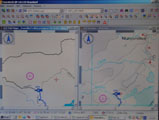
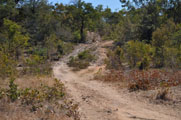
So we head back and really find a small "road" .... just two small tracks of flattened grass that disappear in the field .....
We cannot find it on any of the maps but decide to follow it as long as we can.
In the villages that we pass people look amazed then start waving and cheering when they see us.
It must have been quite a while since the last vehicle (especially tourists!) has come through here .....
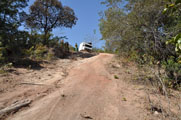
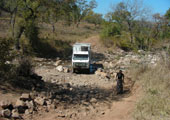
The track gets worse and worse .....
Friendly people show us the way where we have to drive through ... but they are faster on foot than we are in the OKA .....
At one point we are ready to give up and turn around but Susi discovers new posters of the coming elections and that convinces us that there must be a way in from the other side!
Shortly after we see a Toyota coming towards us.
We made it!
Where a Toyota can get through the OKA can get through too!
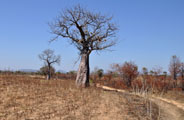
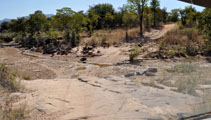
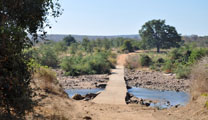
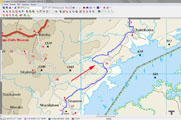
The track starts looking used again.
We cross the last bridge-less crossing then reach
the first new crossing.
We finally reach Chaboboma and after almost 100 km of some of the worst tracks we have ever driven are happy to be back on a "normal" dirt track.
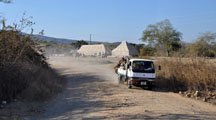
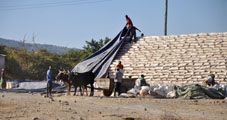
We come past a collection point of the harvested maize.
Mitsubishi Canter
seems to be the largest truck that they use for this task.
In
Munyumbwe we are stopped by some locals: Fish Levy Control.
But we did not fish in Lake Kariba so they let us pass.
In Gwembe we reach the bitumen again but it has such large potholes in it that we would rather drive on a dirt track.
The sharp borders of the holes can easily destroy a tyre if one drives to fast into them.
Then we happily reach the T1 and drive to Monze and the Moorings Campsite.
On Saturday Susi checks the satellite mails she finds a mail from Tom and Dagmar.
They also had their fair part of excitement by driving down to the Lower Zambezi on the track that starts at the Leopard Hill Road.
They had to chop down some wood to get through.
Great, this means that when we drive the track it is all already done for us.
Tom and Dagmar also let us know that they will be on a canoe trip for the next few days.
They also tell us that it is easy to watch the elephants walking / swimming across the river directly from the camp.
We want to see that too and decide that to drive down to the same camp they are in and wait for their return.
We head north towards Lusaka on the T1 and T2.
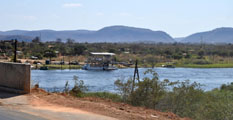
From the bridge crossing the Kafue River we can spot some party boats and small yachts .... this seems to be the recreational area for the people from Lusaka.
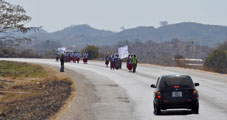
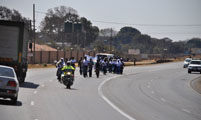
We come past some groups of people, mainly women, that walk on the road, a policeman at the beginning of the group, one at the end of it.
They are from the local churches and are collecting money.
We see that in the group they all wear the same dresses and first think that it is some kind of uniform.
Later on we realise that they are wearing dresses of a political candidate.
Those dresses are sold cheaply or even given away as advertisement for the coming elections!
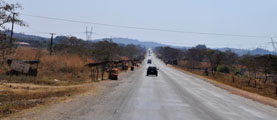
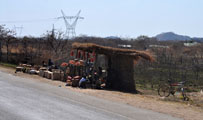
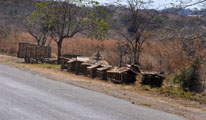
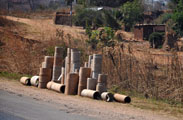
Along the road many people are displaying their goods that are for sale.
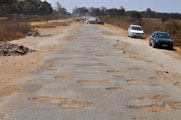
Just outside of Lusaka we turn off the T2 into a small bitumen road that leads to the German butcher, the Majoru Meat Market
(GPS: S 15° 30.448' O 28° 13.679').
The shop reminds us of Europe ... the smell .... the meats ... the breads ...... Sauerkraut, Salzbretzel, sausages, smoked ham etc. etc. ..... yummy!!
We stock up again.
Well after all, this must now last until Nairobi!
We are surprised to see so many locals buying their meat here too.
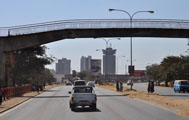
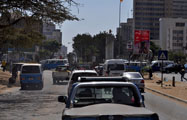
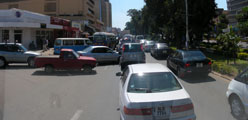
We drive through Lusaka and are surprised to see such modern buildings.
But the traffic jam is pretty good too ....... but very tolerant, no beeping of horns, just a polite hustle and bustle ....
After stocking up on all the rest in the Shoprite in the new Manda Hill Mall it is too late for us to tackle the track to the Lower Zambezi so we head to the Pioneer Camping just outside of Lusaka where we stay for the night.
On Sunday, August 7, we drive to the Leopard Hill Road and then south on it until we reach the small track leading down the escarpment and to the Zambezi.
We know that Tom and Dagmar had gotten through with their MAN truck which is wider and longer then we are so we expect to get through as well.
Tom had sent us a good description on what they found so we now wonder how we will experience it.
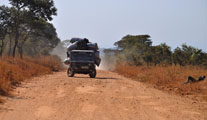
This vehicle does not look too healthy .....
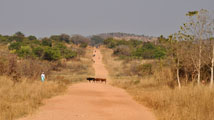
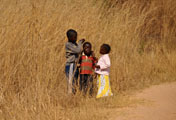
We travel along the dirt track and see many people in their best clothes going to church.
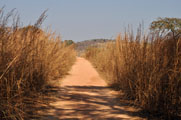
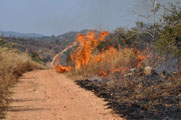 .
.
The grass along the track is as high as the OKA and when we come past a bush fire it is quite warm in the cabin.
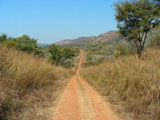
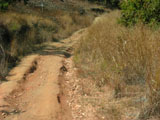
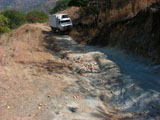
The track is fine until it reaches the escarpment.
Then it virtually follows the power line down into the valley.
It is not the washouts that cause headaches it is the tilting of the track.
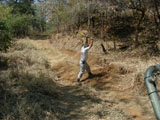


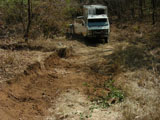
In one particularly nasty section it is so bad that the OKA lifts one of its back wheels .....there is no other choice for us than to fix the track ........
By now the temperature has reached 31 °C .....
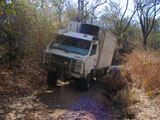
Right after the section with hairpin turns Ruedi misjudges a washout and the OKA slides from the ridge into the wash-out and tilts more and more and more .....
It is a hairy situation and very carefully Susi has to guide Ruedi out of this miserable position.
Ruedi cannot believe that Tom and Dagmar got through this with their MAN - but we know they did!
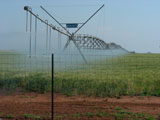
After the approx. 15 km of nasty downhill driving we finally reach the good track again.
The dry and dusty surroundings change to green; irrigation is common and the fields are well maintained.
We are happy to reach the camp.
It has again been one of those days: starting at 8 AM in the morning and finishing at 2:30 PM in the afternoon for just 110 km!
So once we have set up camp we just sit down and drink and drink and drink .....
In the afternoon we start talking to some fellow campers.
Some Dutch tourists, Moniek and Ralf, are looking for some other people to share a boat trip on the Lower Zambezi River tomorrow.
The trip is not really for our budget but they have arranged a special price and they offer us that we would only have to pay for the fuel of the boat.
So we decide to go along.
On Monday we already start our boat trip at 9 AM.
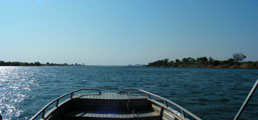
Already shortly after departure we start seeing elephants, hippos and some large crocodiles ... not just one, many!!!!.
We go from one highlight to the other one ......
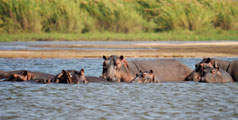
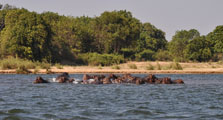
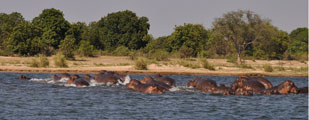
... hippos stampede out of the water .....
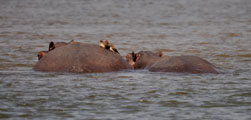
..... others don't seem to be bothered at all by the boat and its occupants .....
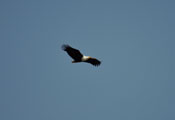
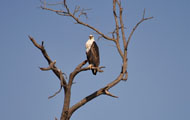
..... African Fish-Eagle ......
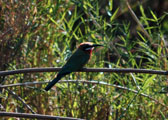
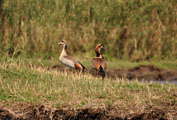
.... White-fronted Bee-eater ..... Egyptian Geese ....
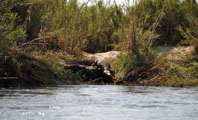
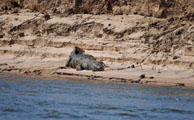
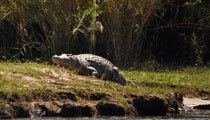
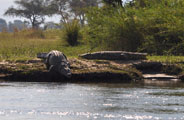
.... Nile Crocodiles
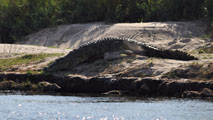
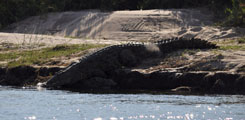
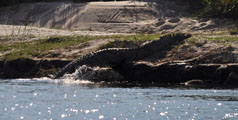
We are amazed to see how quickly they go from 0 to 100 and disappear into the water .....
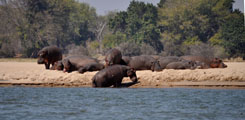
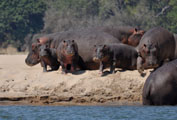
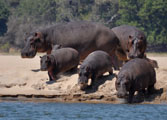
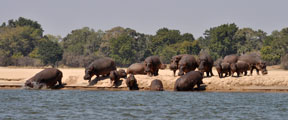
Over and over again we come past large groups of hippos.
First they
just watch us ......
Then the young ones get up and start moving towards the water ...
Then they all run ....
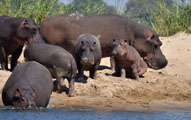
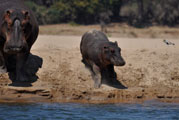
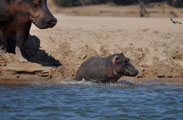
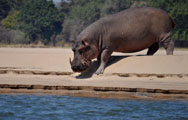
The mamas make sure the little ones get moving ..... and the bull is the last one leaving the camp and getting into the protecting water.
Some of them have amazing tusks!
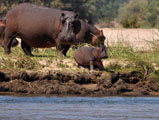
In another spot we can see a very young hippo ... it is still pink and full of wrinkles!
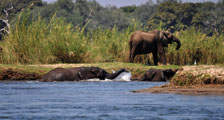
We also come past some elephants that are having a bath.
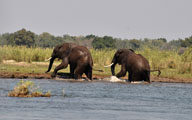
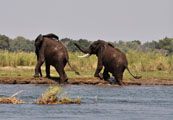
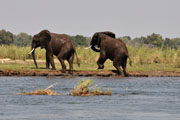
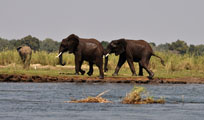
We can watch them getting out of the water .... kneeling on the river bank first, then getting up .....
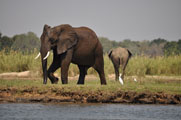
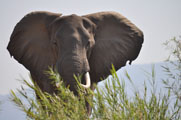
We can get really close and have a close look at them .....
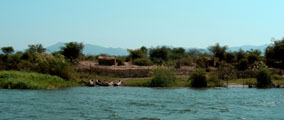
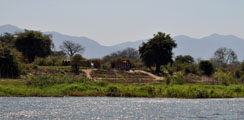
Along the river there are many dwellings.
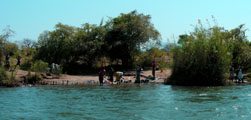
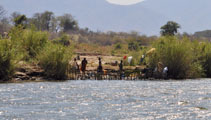
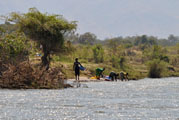
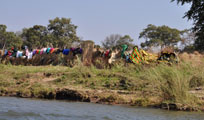
People have built some wooden fences to protect themselves from the crocodiles while fetching water or washing clothes ....
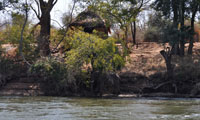
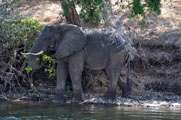
People are used to live together with the elephants.
Some of the elephants come very close to the huts and are not disturbed by boats at all.
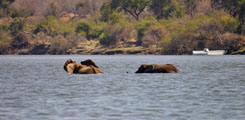
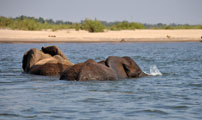
We come past some elephants that are crossing the river.
They walk on the river bed and breathe by holding their trunk up into the air.
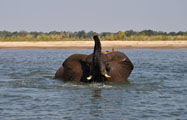
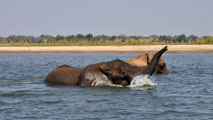
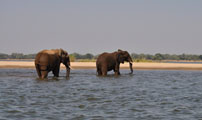
One of them does not like us being so close and starts complaining "elephant style" .... but then they just continue on and exit the river onto an island.
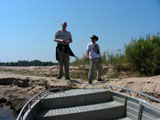
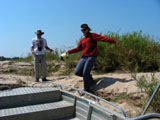
During the few stops that we make with our boat our guide first examined the islands very well and ensures that there are no animals on the island before we are allowed onto it.
Somehow we don't feel to save outside of our little boat ..... there are just too many animals around ...
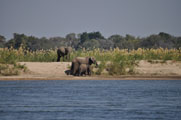
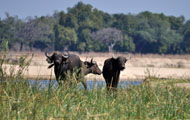
... on each river bank, on each island .... just hundreds if not thousands of animals .....
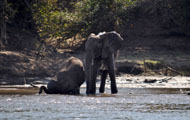
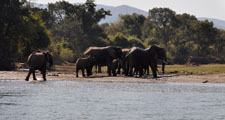
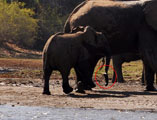
We see a small elephant that has a strange way of drinking water.
Usually elephants get the water with their trunk and spray it into their mouth.
This small elephant actually drinks the water with its mouth .....
Only when the group leaves
we realise that the elephant's trunk is only attached to its head with a small bit or skin .... probably a left-over from a crocodile attack ....
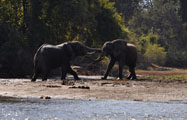
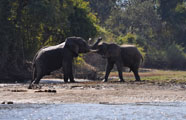
Two young bulls fight ....
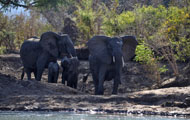
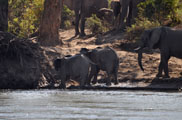
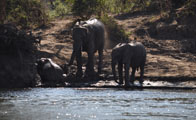
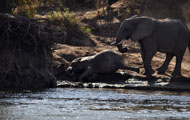
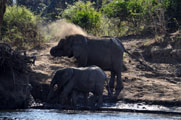
.... some youngsters have a mud bath ... the mother dusts herself ....
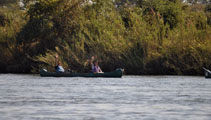
Then we come past our friends Tom and Dagmar with their canoes.
Just to imagine that the canoe could tip over and the passengers fall into this crocodile-infested river is enough for us .... better not even think about it!
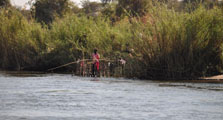
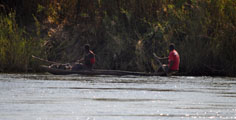
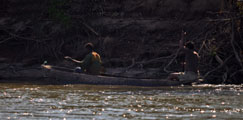
It is a great day and we come back to the camp full of wonderful impressions.
We have Moniek and Ralf over for dinner.
In the middle of cooking on the electrical plate the 220V power decides to stop working.
Ruedi is a bit worried that the inverter could have given up ........
On Tuesday Ruedi tackles the problem with the inverter.
It boils down to be a multiple problem mainly based on corrosion and parts having been rattled loose.
Eventually all is fixed and we have a fully functioning electrical system again.
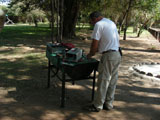

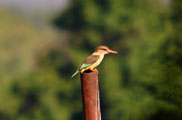
In the afternoon Tom and Dagmar come back from their canoeing trip.
We have a nice evening enjoying the Sauerkraut and meats we had bought at the German butcher the other day.
On Wednesday it is time to head north again.
The manager of the lodge comes past and lets us know that the ferry is working again.
This generates a bit of hectic on the campground and all except us and Thomas and Dagmar leave in a rush.
Eventually we head over to the ferry too.
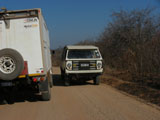
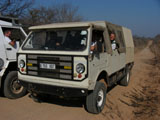
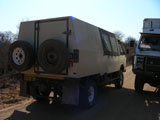

On the way we come past a vehicle that looks exactly like an OKA .... but it is a General Motors South Africa Safari vehicle ... built in Johannesburg by a company called "Safari Conversions" ... amazing!
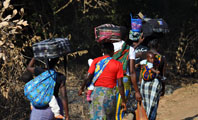
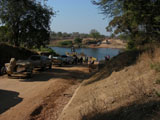
When we reach the ferry a fair bit later we see all the other vehicles queued up .... the ferry had just broken down again .....
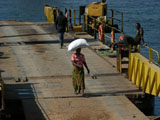
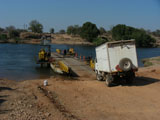
But after a while the engine of the ferry starts up and after coughing a lot of black smoke it actually decides to carry us to the other side of the river - for "only" 40 US$ for a 2-minute ride!
The road to Chirundu is a track with deep potholes, bull dust and unexpected obstacles.
In town the dirt road does not improve at all but in addition there are trucks parked left, right and centre!
They are on their way to Zimbabwe and are waiting for their paperwork.
Eventually we find a way back to the bitumen ....... around the trucks ..... and the pot holes ..... and the people ....... and the animals ....
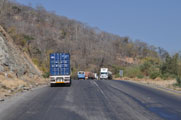
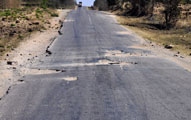
We reach the T2 and head north on "bitumen" ..... or what is left of it between the deep potholes.
Driving on this road requires all the attention of Ruedi.
The potholes are so deep and large that they could easily cause serious damage to the OKA.
Passing a truck is a challenge because the road has to be clear of potholes in both directions to ensure that
-
the truck that has to be passed does not get onto the wrong side of the road to avoid a pothole while one is overtaking and also
- that in the middle of the overtaking manoeuvre one does not have to slow down to a crawl because of a potholes
..... not an easy task!
Then the road from Siavonga and the Lake Kariba dam wall joins and immediately the road becomes smooth and looks quite new.
It even has an overtaking line uphill and an emergency strip!
But once we have reached the top of the escarpment the good road abruptly disappears and we are back with the potholes.
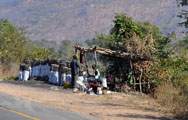
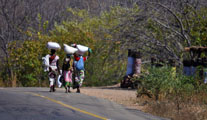
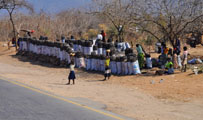
Again many different things are sold along the road.
The production of coal seems to be very popular along this stretch of road.

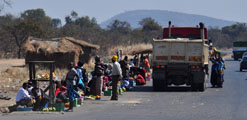

Only when we reach the junction of the T1 from Livingstone and the T2 we are back on the great road that we had already driven a few days ago.
At the intersection people are selling food to drivers ..... Take-Away African stile .....
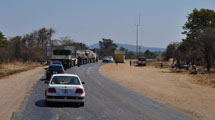
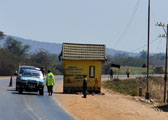
Shortly after we come past a permanent police check point again.
They don't seem to be interested in tourists and wave us through.
There is always something to see along the road .....
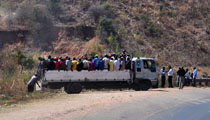
..... here public transport Zambia style .....
Then we reach Lusaka again and after finding a well-assorted SuperSpar in the Crossroads Shopping Mall we settle down in the Pioneer Lodge.
Later in the afternoon Tom and Dagmar arrive too.
But we are not lucky ..... next door a Christian get-together of some sort is happening and they are very loud .... and go on and on until almost midnight ..... not much sleep until then ....
On Thursday morning we head north on the T2 which is in excellent condition.
Today we want to travel to Petauke, approx. 400 km in the north, and from there go off-road together with Tom and Dagmar and reach the South Luangwa National Park.
Let's hope the roads stay as good as they are around Lusaka!
As we drive along we feel a light jolt, as if the diesel tank would be empty and the engine does not get fuel.
As the tank is close to empty Ruedi switches to the second tank.
After a while we feel two more light jolts.
Ruedi immediately gets the OKA off the bitumen and stops.
When he gets out of the cabin he can smell burning oil ..... and then he sees where it comes from.
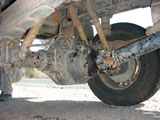
Smoke comes out of the yoke of the back diff!
Not again!
We only got the new diff 11'819 km ago!!!
We are really frustrated and sad.
This could well mean the end of our trip around the world as we cannot afford to pay for a new diff.
We call our friends Tom and Dagmar and inform them of the disaster.
Then we start the already well known work of converting the back axle to a lazy axle.
Luckily at BAE they had given us hub caps were the thread had been removed so we don't have to go through the process of moving the locking hubs to the back to be able to do the conversion.
Soon Tom and Dagmar are here and are surprised how calmly we take this twist of faith.
Well, what else can we do?
After a few hours the work is done and we return to Lusaka.
Tom and Dagmar decide that they will change their plans completely and take another road north.
This is a bit sad as they will not be able to visit South Luangwa anymore.
We head to the Eureka Caravan Park and settle down.
Ruedi informs the OKA dealer in South Africa about what happened.
He will get in contact with BAE and see what can be done.
Frustrated and very sad we sit in the cabin and discuss what the consequences are.
Should BAE decide that this is not a warranty case and that we would have to pay for new diffs we would have to ship the OKA back to Australia.
We just cannot afford to spend any money on an axle that will brake again ....... because the main problem is still there ..... so why bother?
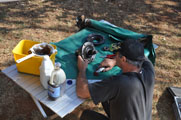
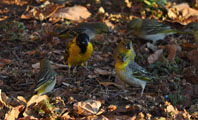
On Friday Ruedi starts having a closer look at the axle.
He just does not see the reason for the failure.
But the oil has an almost golden colour ...... strange.
He continues on dismantling the diff and finds everything that was broken the last few times to be in perfect order .....
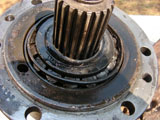
When he removes the yoke assembly he sees that the bearing is gone.
The rollers in it must have blocked for whatever reason.
No wonder the oil was cooking!
Well, this does not look that bad after all.
Ruedi gets on the phone with the OKA dealer and informs him about the problem.
As it is already Friday afternoon they have already gone home for the weekend at British Aerospace (BAE) in Johannesburg.
So the OKA dealer will check with BAE on Monday and see what needs to be done.
For the moment we are stuck in Lusaka, which is not too bad.
Imagine if this fault would have happened just a few days earlier, when we were on those "roads" that did not really exist!
It would have been a lot of hassle to get the OKA out of there ..... probably with a lot of winching and road building.
On Saturday Ruedi gives the cabin a big clean and Susi works on the computer.
Life is peaceful and we even have time for a sun-downer drink in the evening and Ruedi has time to play the guitar.
Sunday passes, Monday too ... no news from BAE ....
Tuesday and Wednesday pass .... still no news from Johannesburg .....
On Thursday
BAE ask Ruedi for more details.
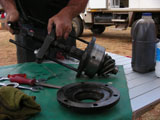
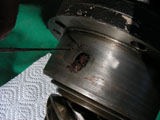
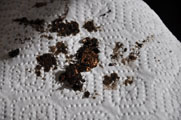

Ruedi gets to work and completely dismantles the yoke assembly.
He finds that some "golden" metal parts have blocked the oil flow to the bearing in the yoke .....
The main question is: where are this golden particles from?
The only clue he has is that the particles are part of the sliding bearings in the spider gear of the diff.
This would also explain the "golden colour" of the oil we reported on the 1'000 km oil change at BAE.
But this would mean the diff is totally gone.
Ruedi sends pictures and his analysis to BAE.
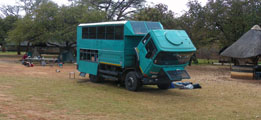
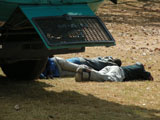
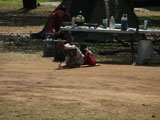
In the afternoon a tour operator bus stops at the camp.
The truck has a problem with its gear box.
The big and heavy box will have to be exchanged in the camp.
A replacement part is on its way from Johannesburg and will be in Lusaka tomorrow.
So the driver and the passengers have no other choice than to take it easy .....
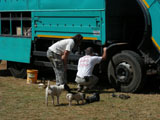
On Friday morning, August 18, a backie with the replacement gear box on its tray arrives.
Soon the job is tackled the "African-way" with no hoists or similar tools to assist with the removal of the heavy gear box, just a few metal bars and man-power.
Ruedi and André have a closer look and help the guys with some tools they require.
It is unbelievable but they successfully finish the job in a few hours time!
In the afternoon BAE confirms that the fault is actually in the spider gear.
It is again a production issue.
The axles in the spider gear were not correctly machined and ground down the bearings.
Both diffs will have the same issue.
This means that also the front diff will fail within the next few thousand kilometres or so.
My goodness - this is very bad news as we have to be able to reach Johannesburg with the front diff.
The South African OKA-dealer tells us that BAE is working on a new solution and that it will take until the end of the month before they will be ready.
End of the month?????
This means that we are in trouble!
We are expecting Ruedi's Godchild Simon for a trip through Kenya and had promised him that we will pick him up in Arusha on September 10th and drive him to Moshi where he will start his trip to the Kilimanjaro.
If we only get the diff repaired by the end of the month this
will most probably not be possible.
On one hand we don't want to worry Simon about the planned Kenya trip with him because we might be able to get the diff fixed and make it to Moshi on time ...... on the other hand we have to make sure, he finds his own way to the departure place for his trip.
So we write to him that we might be delayed and he should organise the transport to Moshi.
He agrees to do so and (lucky us!) does not ask back why .....
The OKA dealer also reports that BAE will replace the existing spider gear by a different type out of a "standard"
truck running on needle bearings instead of sliding bearings.
Without any bad intension we also report this status to OKA which immediately generates some major headache to all parties.
Without getting into the details: BAE tells the South African OKA dealer that we gave confidential information to OKA and that they will no longer help us!
For us this is a major catastrophe!
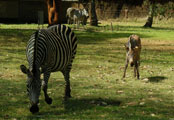
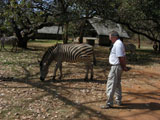
Some Zebras come into the camp and are not afraid of people at all .... they are almost too friendly and have to be shooed away from food.
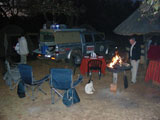
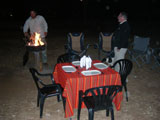
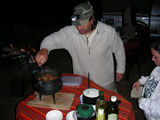
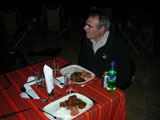
In the evening we are invited over to André and Lucille for dinner.
On Saturday we get the next blow ...... we receive the news that OKA in Australia has problems paying their bills and that OKA will most likely close down its operations.
This is very bad for us as we rely on OKA for specific spares and for information on OEM parts.
We might now lose our parts supplier.
We are totally devastated and don't know what to do .....
On Sunday Ruedi prepares a list of all the parts he needs to know the original part and part-manufacturer and sends it to OKA.
In the evening we invite André and Lucille for dinner.
We cook some Rösti, a Swiss national speciality.
André is excited about it and wants to know how to prepare it.
On Monday OKA replies that they will look into supplying some of the numbers.
After some clarifying mails we receive news from BAE that they are ready with the new parts and that we should start driving to Johannesburg.
Wow - many thanks to the guys at BAE!!!
When we head over to André and Lucille to inform them that we are leaving to Johannesburg they tell us that André has prepared Rösti for breakfast and is working on some special Röstis he wants to create .....
Good on you André!
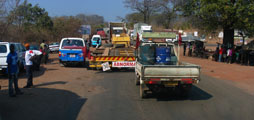
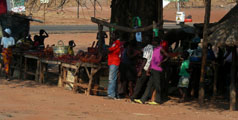
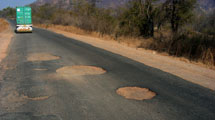
On Tuesday, August 23, we leave Lusaka and travel south to Chirundu, where we stay at a camp directly at the Zambezi River, very pretty.
And that is the end of the Zambia journal ...... | 
![]() Created by Level X Webdesign
Created by Level X Webdesign